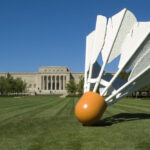Navigating Philadelphia by bicycle presents unique challenges, especially when faced with daunting intersections like Eakins Oval. For cyclists heading westbound towards Drexel University and Powelton Village, the Spring Garden Street Bridge is a crucial link. However, the current routes often involve contending with high-speed traffic or detouring significantly. Many Philadelphia cyclists have experienced near misses while trying to safely navigate this area.
While the Schuylkill Banks trail offers a valuable resource for bike commuters, it can add considerable distance to journeys aimed at West Philadelphia via Spring Garden Street. The recent closure of the Race Street entrance further complicates matters, leaving cyclists with fewer safe options. For those seeking a direct route, the surface streets can feel perilous, and sidewalk riding is not always feasible or legal.
Beneath the bustling Eakins Oval lies a potential, yet overlooked, alternative: the Spring Garden Tunnel. This tunnel, once a passage for the #43 streetcar until the mid-1950s, was later repurposed for westbound car traffic. Historically significant and structurally sound, the Spring Garden Tunnel presents an intriguing possibility for enhancing bike infrastructure in Philadelphia.
Currently, only the left lane of the Spring Garden Tunnel is utilized, raising the question: could the vacant right lane be repurposed to create a dedicated bike lane? This concept seems logical and potentially transformative for improving cyclist safety and accessibility along Spring Garden Street. However, exploring this idea reveals complexities and potential drawbacks that warrant careful consideration.
To gain firsthand insight, a cycling expedition through the Spring Garden Tunnel was undertaken. Entering from the Eakins Oval side on a Sunday afternoon, even with lighter traffic, navigating to the tunnel entrance proved challenging. This initial experience underscored the need for safer transitions for cyclists approaching the tunnel area.
Inside the Spring Garden Tunnel, the unused right lane appears spacious enough to accommodate a bike lane. The road surface is generally well-maintained. However, several critical issues emerged during the assessment. Drainage grates, running parallel to the direction of bicycle wheels, pose a significant hazard. These grates could easily trap wheels, leading to accidents, especially at higher speeds.
Dim lighting within the tunnel is another concern. Reduced visibility compromises safety and could deter cyclists from using the tunnel, particularly at night or during inclement weather. Furthermore, the tunnel exit presents a blind spot due to supporting pillars. The merging of the two roadways occurs abruptly at the exit, leaving limited space for cyclists to safely integrate with car traffic. Navigating this exit requires relying heavily on auditory cues to anticipate approaching vehicles, a less than ideal situation for cyclist safety.
Converting the unused lane of the Spring Garden Tunnel into a bike route, while seemingly straightforward, encounters significant bureaucratic hurdles. Sarah Clark Stuart, Policy Director at the Bicycle Coalition, highlights the slow pace of city infrastructure changes. While acknowledging the tunnel concept’s potential, she noted its absence from the city’s Bike/Ped Master Plan. Concerns regarding traffic speed, inadequate lighting, and the challenging drainage grates were also raised as significant obstacles to quick implementation. Even seemingly minor adjustments like grate replacement can become protracted processes within city infrastructure projects.
Jeannette Brugger from the Philadelphia City Planning Commission echoed these sentiments. While recognizing the desire for safer alternatives to Eakins Oval and acknowledging her husband’s long-held similar suggestion, she pointed out substantial drawbacks to prioritizing the Spring Garden Tunnel for bike use.
Personal safety emerged as a primary concern. Compared to the Fifth Street tunnel, the Spring Garden Tunnel is longer and darker, raising security questions. While increased police presence or security cameras are possibilities, these measures have not been prioritized for this location. The project timeline for such a conversion would likely be extensive, involving addressing lighting, security, barrier adjustments, and entrance/exit modifications. These complexities extend far beyond simply striping a bike lane, necessitating considerable planning, resources, and legislative processes.
In conclusion, while the Spring Garden Tunnel offers a tempting solution for safer westbound cycling on Spring Garden Street, its conversion is far from simple or imminent. Overcoming safety concerns, navigating bureaucratic processes, securing funding, and demonstrating clear public need are substantial prerequisites. Until such a project gains momentum, cyclists seeking to avoid Eakins Oval can utilize alternative routes like Anne d’Harnoncourt Drive behind the Art Museum, embracing the hills as part of the Philadelphia cycling experience.

